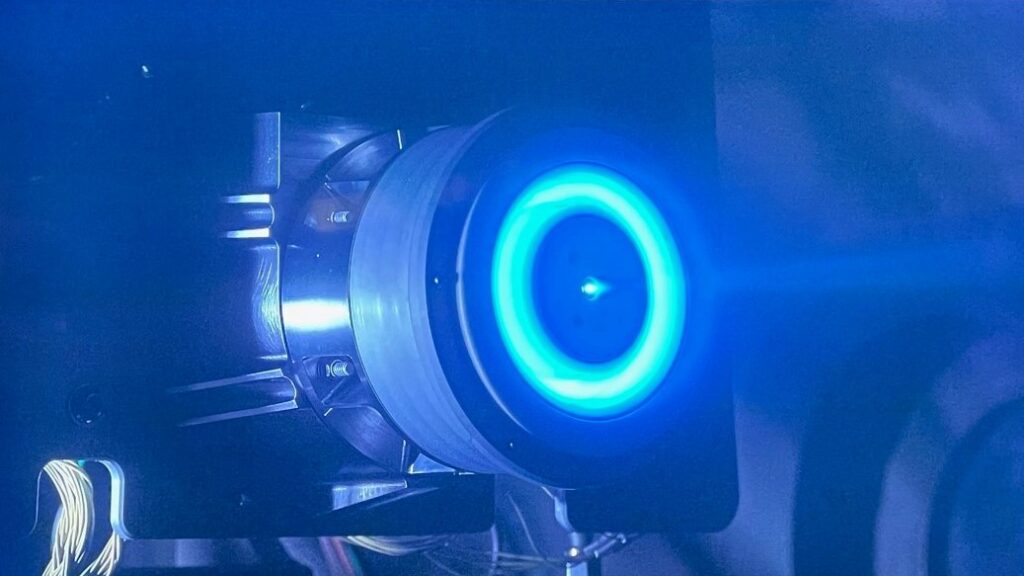
The new SpaceLogistics Mission Extension Pod (MEP) has achieved so-called first light of its new electric propulsion unit. (Photo: SpaceLogistics)
SATELLITE 2022: SpaceLogistics’ robotic satellite servicing spacecraft have sparked interest from the Space Force — with an eye not just on keeping military satellites operating longer but also opening the possibility of upgrading or adding new payloads while in orbit, says new company president Rob Hauge.
“In fact, just this past week, I was in Los Angeles briefing the senior leadership at Space Systems Command on our capabilities and they’re interested in mission extension vehicles, as well as mission extension pods,” he told Breaking Defense and Space News in a joint interview today. “And they’ve asked for follow up: more in-depth briefings with more of their technical teams to understand what we’re offering.”
Space Systems Command (SSC) is the Space Force’s major acquisition arm. The service, Hauge explained, is not just interested in life extension for legacy satellites, but also the potential for SpaceLogistic’s in-development satellite servicing spacecraft to allow it to either update older payloads or add new hosted payloads that could provide backups for other systems.
“It’s not just resiliency from a life-extension perspective. We’ve got the potential to actually include other payloads as well,” he said. “So the way we like to phrase it is: it’s not just about life extension, we have the potential to enhance as well.”
For example, Space Force is interested in putting hosted payloads on satellites in the Geosynchronous Orbit (GEO) belt some 36,000 km above sea level to provide space domain awareness — which is a top priority for Space Command leader Gen. Jim Dickinson.
Hauge, who took up leadership of SpaceLogistics in January and has a background in the Air Force and at the National Reconnaissance Office (NRO), said that he can see potential satellite servicing applications for NRO as well — although of course the company cannot speak about any discussions with the spy agency due to classification restrictions.
Considering new ways of doing business and new models such as life-extension isn’t easy for government customers like the Space Force, Hauge said, which has to work within fixed budget and performance parameters.
“It’s a challenge if I look at things from their perspective, because you’ve got a program office — which I’ve worked in multiple times — and they’re all about building that next-generation system and keeping the older ones flying. And we’re coming in saying, ‘actually, on that next-generation system, you’ve got, potentially, more time,'” he said. “How does that fit in when you’ve already got a budget profile that’s laid in?
“But what I’m really pleased to see is the Space Force is demonstrating that they want to be innovative, they’re demonstrating that they want to leverage commercial and they’re clearly seeing that we’ve got the opportunity to offer them resiliency in a unique way for their legacy systems that they’ve never had before,” he added.
Next-Generation Designs
SpaceLogistics, a subsidiary of Northrop Grumman, in February 2020 launched its first Mission Extension Vehicle-1 (MEV-1) robotic spacecraft to dock with, reposition, provide power for, and basically “fly” Intelsat IS-901 to keep it alive. It launched MEV-2 in August 2020, and in April 2021 that spacecraft docked with Intelsat IS-1002 to perform a similar life-extension mission for the dying sat.
Hauge explained that the MEVs will stay on orbit, waiting to be tasked for new missions, for about 15 years. SpaceLogistics is in essence leasing vehicles to Intelsat for the next five years, with an option to renew — an option that SpaceLogistics expects to be exercised.
“As soon as Intelsat says ‘we’re ready to move on,’ we’ve got a whole bunch of companies that are lined up,” he said. “Which is good. That tells us that the market is there.”
But the firm hasn’t any plans to make more of the school-bus sized MEVs. Rather, it’s moving to put in orbit a pair of servicing spacecraft that will cost clients less to use: the Mission Robotic Vehicle (MRV), and the Mission Extension Pod (MEP).
The MRV will be able to dock with a spacecraft, but also incorporates a robotic arm developed and integrated by the Naval Research Laboratory and provided to the firm by DARPA. This will “expand the benefits the MEV currently offers to our clients to include detailed robotic inspection, augmentation, relocation, repair, active debris removal, and docking with non-standard client spacecraft interfaces,” according to SpaceLogistics’ website.
The MEP is a life extension vehicle, but much smaller than the MEV (“about the size of dishwasher,” Hauge said) and cheaper. He said the cost for renting the MEVs currently is “on the order of a half to a quarter” of the $300 million and $500 million price tag of building and launching a satellite to GEO. The price for a client buying the new MEP is “dramatically less,” he added.
Another key difference between the MEV and the MEP is that, instead of actually flying the client satellite for the operator like the MEVs do, the MEP will simply provide an electric propulsion motor that will allow station keeping without using up the satellite’s own fuel. The MEPs also have a shorter life span: six years as opposed to the MEV’s 15 years, he said.
Both the MEP and the MRV spacecraft are “on track” for a critical design review this year, Hauge said, and plans are for the MRV to carry several MEPs to orbit in 2024.
Further, SpaceLogistics has a first commercial customer for the MEP: Australian telecommunications firm Optus, which last month signed up to buy a MEP in 2025 for its now 12-years-on-orbit D3 satellite. In addition, SpaceLogistics has so-called term sheets “with five other operators right now, which essentially is a seat reservation for a Mission Extension Pod,” Hauge said.






















